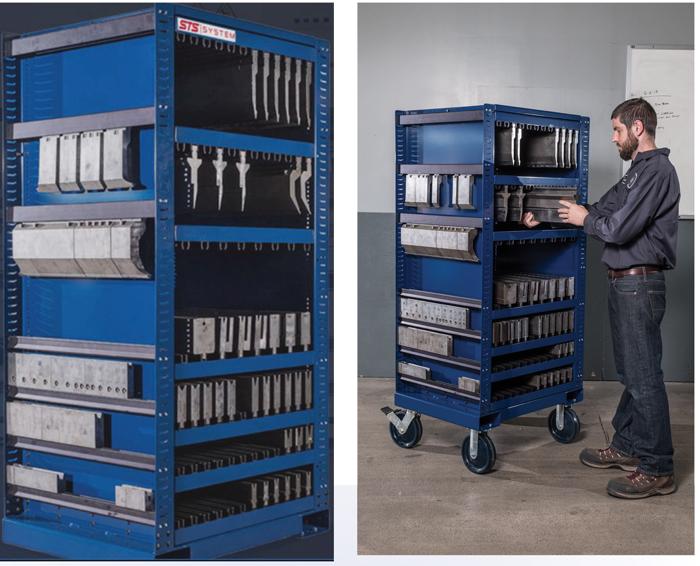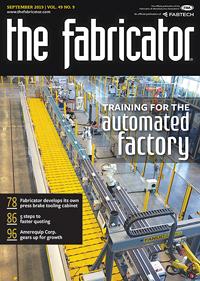Editor-in-Chief
- FMA
- The Fabricator
- FABTECH
- Canadian Metalworking
Categories
- Additive Manufacturing
- Aluminum Welding
- Arc Welding
- Assembly and Joining
- Automation and Robotics
- Bending and Forming
- Consumables
- Cutting and Weld Prep
- Electric Vehicles
- En Español
- Finishing
- Hydroforming
- Laser Cutting
- Laser Welding
- Machining
- Manufacturing Software
- Materials Handling
- Metals/Materials
- Oxyfuel Cutting
- Plasma Cutting
- Power Tools
- Punching and Other Holemaking
- Roll Forming
- Safety
- Sawing
- Shearing
- Shop Management
- Testing and Measuring
- Tube and Pipe Fabrication
- Tube and Pipe Production
- Waterjet Cutting
Industry Directory
Webcasts
Podcasts
FAB 40
Advertise
Subscribe
Account Login
Search
The wisdom of press brake tooling organization
Fabricator builds storage cabinet that protects the tooling and helps to streamline bending operations
- By Dan Davis
- August 31, 2019
- Article
- Bending and Forming

»As a business owner, Kirk McCauley of American Engineering and Metalworking, North Canton, Ohio, is well aware of the investment that a shop makes in precision press brake tooling. To protect that investment, he invented the STS System press brake tooling cabinet. Photos courtesy of American Engineering and Metalworking.
In 2006 Kirk McCauley was just starting out as a fabricator. He had a new press brake and wanted to invest in top-of-the-line tooling, but he couldn’t quite afford it then. A few years later, however, he invested in Wila tooling and knew it would make a big difference in delivering precision parts and with quick changeovers.
Thirteen years later he remains committed to investing in the best machines and tools to produce metal parts and assemblies for his customers. He estimates his company, American Engineering and Metalworking (AEM), has at least $300,000 worth of press brake tooling.
“There’s no such thing as having a couple of tools and being competitive anymore,” McCauley said. “You have to have the whole gamut of tools because customers are designing parts that are more challenging. The machine will do the job, but you need the right tools as well. The tools are equally as important.”
McCauley has had machinery come and go out of his North Canton, Ohio, facility over the years as he’s looked to stay current with the latest cutting and bending technology. Tooling, on the other hand, is more of a long-term investment, and he’s always been interested in protecting it. He had looked at cabinets and talked with the tooling manufacturers, but McCauley said no one really had anything that was exactly what he was looking for. That’s why he came up with his own storage cabinet design.
Burgeoning Bending Business
As the 26-person shop has grown over the years, AEM has upgraded its bending operations. The most recent investment, a 350-ton Accurpress, arrived in late July. It has a 10-foot-wide bed and a bending window of almost 31 inches when the ram is completely raised. The brake, which has an angle measuring system and a material lift-assist for large parts, was specially designed to accommodate workpieces made of advanced high-strength steel alloys and thick steel plate.
“I’m trying to challenge my customers to change their designs,” McCauley said. “Instead of taking two 1-in. pieces of plate and welding them together, I’m asking them to think bigger. Welding plate is very, very slow because you need multiple passes, and you might need to preheat the piece first. Also, after welding plate, it often requires post-machining to get the weldment to print specs. There’s just a lot of time and inefficiency in welding thick plate.”
Designing welding out of the production process results in a savings for the manufacturer, McCauley added.
“Today’s lasers are excellent at cutting thick plate,” he said. “Combining precision blanks with precision bending machines and tooling can pay off in a reduction in production costs and an increase in throughput.”
AEM’s bending area also houses three TRUMPF press brakes, a 36-ton model for smaller jobs and 200- and 350-ton models for larger work. If needed, all the press brakes have lightweight material handling cranes in front of them to get parts in and out of the machines faster.
Of course, state-of-the-art bending machines can deliver precise parts only if they use precision tooling. Even as a young fabricator, McCauley recognized this, and he was always interested in protecting that investment. That likely wasn’t going to be the case with an operator who might be keeping the tooling in a tool chest with drawers, where the tooling is placed somewhat haphazardly after use and where nicks and dents can easily occur.

»Press brake tooling is oriented in the same manner as it would be in the brake. This limits the amount of flipping and repositioning that an operator has to do when setting up a job.
“Let’s say the tooling has some defects in the mating surface where the tooling clamps. The operator isn’t going to notice the defect. It looks usable to him,” McCauley said. “So he takes the tool and puts it into your $500,000 press brake with its $50,000 clamping unit. The tooling is in there and 200 tons come down on that with the first bend. That defect is now affecting the ram of the press. The clamping unit starts to wear, and over time it loses its precision.”
That’s why McCauley’s patented cabinet design doesn’t have the tools on top of each other. Tools hang independently and can be grouped into sections as they would be placed in the brake.
AEM’s press brake operators are cross-trained and can work all of the press brakes. McCauley said that they understand the importance of the tooling and ensure they handle it with care.
That may not hold true for other large metal fabricators that have more press brakes and a much larger investment in tooling. Skilled operators are not as plentiful as they once were, and as these companies bring in new blood, they may not be as careful or knowledgeable about protecting the tooling. That can sabotage a fabricator’s ability to maintain its equipment—and ultimately its reputation if quality issues arise.
“Spending a few thousand dollars to protect that investment is smart business,” McCauley said.
Avoiding Waste
McCauley’s STS System cabinets also ensure that press brake operators can see the tooling, whether it is hung from the side or inside the cabinet, where the silhouette is visible. He said that it’s about creating a visual reminder for employees so that they know where to return tooling after a bending job. He pointed to the example of a shadow board, often seen near assembly areas, where tools are hung; when a tool is pulled from the board, a cutout, which acts as a sort of shadow for the tool, remains on the board.
“That is the way the cabinet is designed. There are no closed spaces, and you can see all of the small tools,” McCauley said.
The goal is to avoid this scenario: A press brake operator looks through a cabinet with drawers, opening multiple drawers just to find the right tooling. McCauley said all of that time spent looking is time that could be spent making parts.
He added that the storage cabinet also provides an ergonomic benefit for the press brake operators. Because the tooling is oriented in the same manner in which it is installed into the press brake, the operator doesn’t have to flip the heavy tooling around to set up the job, which is the case if the tooling is resting flat in a drawer-style cabinet.
Also, some shops don’t even make use of cabinets, instead storing their tooling on shelving or pallets. McCauley said that creates an additional chance of injury, forcing brake operators to bend over and lift up the tooling.
With the additional material handling comes more opportunities to mishandle the tooling, perhaps even dropping it. That could lead to damaged tooling or an injury.
The Ripple Effect
Like most shop floor improvements, when people see changes that work, they will buy in. McCauley has witnessed just that in the AEM bending department and word is getting out.
One of AEM’s customers had STS System cabinets in its bending department, and one of the press brake operators appreciated their straightforward design. When that press brake operator left that company to go work for another fabricator in another state, he spread the word about the press brake tooling cabinets. His employer finally was able to track down AEM and get their own cabinets. The search is now a bit easier. McCauley has launched a website to sell the cabinets.“Just the fact that this is built by somebody that uses a press brake every day makes a difference,” he said.It may come as a surprise to some that the cabinets don’t come preassembled. McCauley said that is because the cabinets can be adjusted for each fabricator’s unique requirements. For instance, shelving can be adjusted to store really tall tooling, which a lot of shops are gravitating to as they take on more complex parts. Meanwhile, a cabinet near a small press brake can have its shelving adjusted to house smaller tooling. AEM organizes its tooling according to metal thickness. Some cabinets contain tooling for work to be done on blanks 10 gauge and thinner. Others house tooling for material 10 ga. to 0.25 in. All of the cabinets can be adjusted depending on what type of tooling needs to be stored.In the meantime, McCauley said he has some other ideas about press brake tooling storage and eliminating waste in the press brake setup process. It’s just a matter of finding the time to test out those ideas—which can be a challenge when the inventor is running a job shop. American Engineering and Metalworking, www.aemquality.comSTS System, www.bendingtoolstorage.comAbout the Author

Dan Davis
2135 Point Blvd.
Elgin, IL 60123
815-227-8281
Dan Davis is editor-in-chief of The Fabricator, the industry's most widely circulated metal fabricating magazine, and its sister publications, The Tube & Pipe Journal and The Welder. He has been with the publications since April 2002.
subscribe now

The Fabricator is North America's leading magazine for the metal forming and fabricating industry. The magazine delivers the news, technical articles, and case histories that enable fabricators to do their jobs more efficiently. The Fabricator has served the industry since 1970.
start your free subscription- Stay connected from anywhere

Easily access valuable industry resources now with full access to the digital edition of The Fabricator.

Easily access valuable industry resources now with full access to the digital edition of The Welder.

Easily access valuable industry resources now with full access to the digital edition of The Tube and Pipe Journal.
- Podcasting
- Podcast:
- The Fabricator Podcast
- Published:
- 04/16/2024
- Running Time:
- 63:29
In this episode of The Fabricator Podcast, Caleb Chamberlain, co-founder and CEO of OSH Cut, discusses his company’s...
- Industry Events
16th Annual Safety Conference
- April 30 - May 1, 2024
- Elgin,
Pipe and Tube Conference
- May 21 - 22, 2024
- Omaha, NE
World-Class Roll Forming Workshop
- June 5 - 6, 2024
- Louisville, KY
Advanced Laser Application Workshop
- June 25 - 27, 2024
- Novi, MI
































